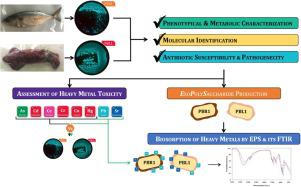Microbiological Research ( IF 6.1 ) Pub Date : 2020-06-18 , DOI: 10.1016/j.micres.2020.126526 Paritosh Parmar 1 , Arpit Shukla 1 , Dweipayan Goswami 1 , Shailendra Gaur 1 , Baldev Patel 1 , Meenu Saraf 1

|
The current study depicts the isolation of luminescent bacteria from fish and squid samples that were collected from Veraval fish harbour. From Indian mackerel, total 14 and from squid, total 23 bioluminescent bacteria were isolated using luminescence agar medium. Two bioluminescent bacteria with highest relative luminescence intensity PBR1 and PBL1 were selected. These two isolates were subjected to detailed biochemical characterization and were tested positive for 5 out of 13 biochemical tests. Furthermore, both PBR1 and PBL1 were able to ferment cellobiose, dextrose, fructose, galactose, maltose, mannose, sucrose and trehalose with acid production. Based on 16S rRNA partial gene sequence analysis, PBR1 was identified as Vibrio alginolyticus and PBL1 as V. rotiferianus. Antibiotic susceptibility test using paper-disc method showed that PBR1 and PBL1 were sensitive to chloramphenicol, ciprofloxacin, co-trimoxazole, gatifloxacin, levofloxacin, linezolid ad roxithromycin out of 18 antibiotics tested. Moreover, both strains were evaluated for their exopolysachharide (EPS) producing ability where PBR1 and PBL1 were able to yield 1.34 g% (w/v) and 2.45 g% (w/v) EPS respectively from 5 g% (v/v) sucrose concentration. Heavy metal toxicity assessment was carried out using agar well diffusion method with eight heavy metals and both the strains were sensitive to As(III), Cd(II), Ce(II), Cr(III), Cu(II), Hg(II) and while they showed resistance to Pb(II) and Sr(II). Based on these results, a study was conducted to demonstrate bio-removal of Pb and Sr by EPS of PBR1 and PBL1. Fourier transform infrared (FTIR) spectra revealed the functional groups of EPS involved in interaction with the heavy metals. Owing to the sensitivity for the remaining heavy metals, these bioluminescent bacteria can be used further for the development of luminescence-based biosensor.
中文翻译:

全面描述了新型的重金属耐受性和可产生EPS的生物发光的藻溶弧菌PBR1和轮虫弧菌PBL1,它们局限于海洋生物。
当前的研究描绘了从Veraval鱼港收集的鱼和鱿鱼样品中分离出发光细菌。使用发光琼脂培养基从印度鲭鱼中分离出总共14种鱼,从鱿鱼中分离出总共23种生物发光细菌。选择两种具有最高相对发光强度PBR1和PBL1的生物发光细菌。对这两个分离株进行了详细的生化表征,并在13个生化测试中有5个测试呈阳性。此外,PBR1和PBL1都能够发酵纤维二糖,右旋糖,果糖,半乳糖,麦芽糖,甘露糖,蔗糖和海藻糖,并产生酸。根据16S rRNA部分基因序列分析,将PBR1鉴定为溶藻弧菌,将PBL1鉴定为轮状弧菌。。通过纸碟法进行的药敏试验表明,在18种抗生素中,PBR1和PBL1对氯霉素,环丙沙星,复方新诺明,加替沙星,左氧氟沙星,利奈唑胺和罗红霉素敏感。此外,评估了两种菌株的胞外多糖(EPS)产生能力,其中PBR1和PBL1能够分别从5 g%(v / v)产生1.34 g%(w / v)和2.45 g%(w / v)EPS蔗糖浓度。使用琼脂井扩散法对8种重金属进行重金属毒性评估,两个菌株均对As(III),Cd(II),Ce(II),Cr(III),Cu(II),Hg( II),尽管它们显示出对Pb(II)和Sr(II)的抗性。基于这些结果,进行了研究,以证明PBR1和PBL1的EPS可生物去除Pb和Sr。傅立叶变换红外(FTIR)光谱揭示了EPS与重金属相互作用所涉及的官能团。由于对其余重金属的敏感性,这些生物发光细菌可进一步用于开发基于发光的生物传感器。











































 京公网安备 11010802027423号
京公网安备 11010802027423号